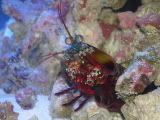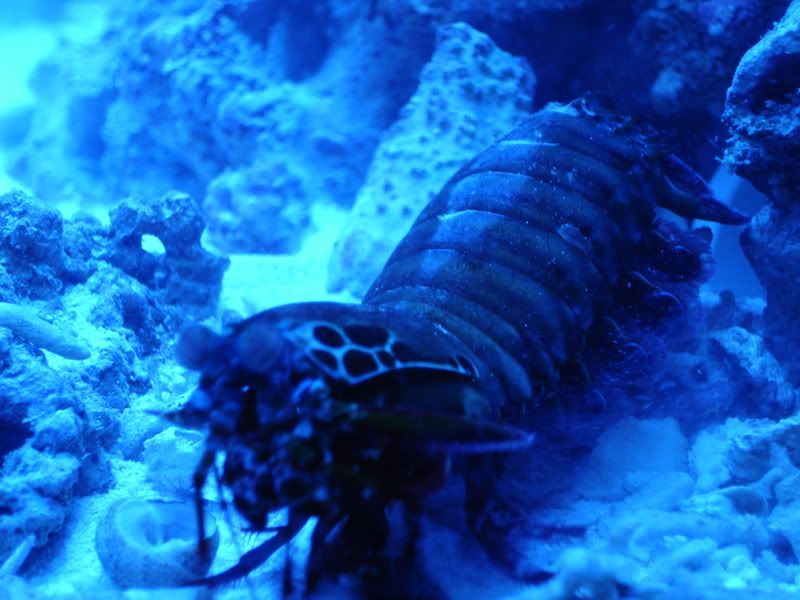

|
|
|
#1
|
|||
|
|||
|
O.s. Molt ?
Picked up the peacock yesterday that my fiancee got me for x-mas.
I'm a little bummed b/c it appears to have some shell disease going on. This mantis has been in the lfs for a couple of months and I don't think it was fed correctly or enough. It ate a couple pieces of krill today that I had soaked in Selcon. I have a question regarding molts in O.s. - Can you tell when a mantis is getting ready to molt other than behavior, like does it's appearance change? My peacock (yet unnamed) all of a sudden has a light white "stripe" running up the middle of it's back - It was not there yesterday and I don't recall seeing it earlier today while working on the tank. LFS owner can't tell me if / when it molted while at the store. My fiancee thinks that maybe they're "rub" marks - I have a 2.5" "Y" PVC burrow under the LR in the tank. The mantis has been busy engineering doors for the 3 openings - This is behavior that I typically see of my smithii prior to molt. Of course, it may just be personalizing it's new tank. Lights are off now, so I can't post pics. Will try and do so tomorrow. Thanks in advance for any input concerning the white stripe. Ryan |
|
#2
|
|||
|
|||
|
My peacock becomes aggressive, then goes into "construction mode", then reclusive. No noticeable appearance change.
The white stripe is often signs of a failed molt. The old skin didn't split like it was supposed to. If this is what's going on, this is unfortunately fatal. I hope that's not the case here. Dan |
|
#3
|
|||
|
|||
|
I thought that might be the case - I still hope not though.
I just thought it curious that the white stripe developed so quickly. |
|
#4
|
|||
|
|||
|
Here's a couple pics - The 2nd one shows the "white stripe" that I'm talking about
  Ryan |
|
#5
|
|||
|
|||
|
Ryan,
I'm not sure what the light stripe on the abdominal tergites is, but I can't remember seeing something like this associated with a molt. There are morphological changes associate with the molt that you can see, but they are hard to see without a dissecting scope. The most definitive is to look at the setae (hairs) on the gills and antennal scale. As the new ones develop prior to the molt, they form growing into the the scale or gill. These structures are fairly transparent and you can see the setae forming. A day or two prior to the molt, you can also see the old cuticle lifting up from the new. When the molt occurs, the hydrostatic pressure inside the animal increases and the setae turn inside out much like the finger of a rubber glove. One of the common failures during molting is that the animal cannot generate sufficient pressure to inflate the setae and/or rupture the membranes that must split to allow molting. The other change that is fairly easy to see is the weakening and splitting of the mid line suture on the 6th, 7th and 8th thoracic tergites. These start to weaken a few hours prior to molting. This is the point that splits beginning the molt and the opening through which the animal emerges from the old cuticle. Roy |
|
#6
|
|||
|
|||
|
It looks like some kind of mold...or worn down. Hard to tell but is looks slightly fuzzy....
Dan
__________________
This laughter is ill-informed! "Sanity? What would I do with something as useless as that?" -Kennpachi |
|
#7
|
|||
|
|||
|
Ryan,
I have a large green male O.s that is preparing to molt. It is probably a day away. I looked at it this afternoon and it has the same pattern on the abdominal tergites. We will see! Roy |
|
#8
|
|||
|
|||
|
thanks Dr. Roy - Good news I hope.
Mine has been taking selcon soaked krill for the last few days - It has also closed up the doors on two of it's caves. I notice too that today it has killed a smaller turbo snail. It seems a bit more aggressive as well, it like to come from it's burrow and "flex" when I come near the tank to check the sump located below the display. I am trying to convince myself that these are all signs of preparation for molting. Dr. Roy - In your experience, how quickly does shell disease spread in an affected animal? Does a single "sore" (for lack of better words) continue to expand larger and take over or do the "sores" tend to migrate and spread? Thanks - Keep us posted on the molt process of O.s in the lab Ryan |
|
#9
|
|||
|
|||
|
I wish I could give you a definitive answer. It really seems to depend on the size and health of the animal, the quality of the water, whether you are running UV sterilization, etc., etc. From my experience, all things being average, time from a single lesion to a severe infection is at least a couple of months. If the animal successfully molts and conditions are good, the lesion can heal and not spread. If the lesion has penetrated the cuticle, shell disease is a lot harder to cure and is usually fatal.
Roy |
|
#10
|
|||
|
|||
|
The male O. scyllarus molted this morning as predicted. Clearly the lighter patch on the back is part of the process. Thanks for pointing this out to me. It will prove useful in predicting molts. Don't know yet if it happens in females or if they are just too light in color to notice it.
Roy |
|
#11
|
|||
|
|||
|
That's great news!
I'm glad to have been able to contribute to your studies. I hope my mantis molts soon... |
|
|